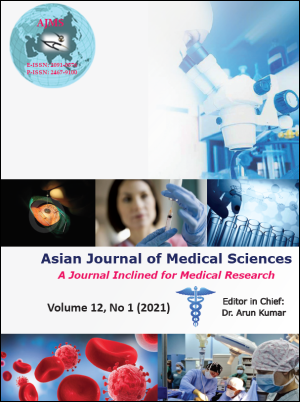Fundus changes in high myopic Kashmiri population
Keywords:
High Myopia, fundus changes, Kashmiri populationAbstract
Background: High myopia (defined as myopia of -6D or more) is one of the main causes of visual impairment worldwide. High myopia is always accompanied by pathological structural changes such as axial elongation, posterior staphyloma, lacquer crack formation, thinning of the retina and choroid, and choroidal neovascularization.
Aims and Objectives: The purpose of this study was to examine the fundus changes in eyes with high myopia.
Materials and Methods: All study participants underwent dilated fundus examination and fundus photography. Myopia-related macular (posterior staphyloma, lacquer cracks, Fuchs spot, myopic chorioretinal atrophy, and myopic choroidal neovascularization)and optic disc (optic nerve head tilt,optic disc dimensions, and peripapillary atrophy) changes were evaluated.
Results: Statistical analysis was performed to evaluate fundus changes in eyes with high myopia. Data analysis included 107 eyes of 57 patients.Mean ± SE was 12.07 ± 3.184D in eyes with high myopia. Mean ± AL was 26.68± 1.577mm in eyes with high myopia. The mean age was 28.54 ± 9.44 years(14-50 years). Fundus changes were: Temporal crescent in 56 (52.33%) eyes, tessellated fundus appearance in 52(48.59%) eyes, lacquer cracks in 40 (37.38%) eyes, tilted disc in 30 (28%) eyes, lattice degeneration in 20(18.69%) eyes, posterior staphyloma in 20(18.69%) eyes, focal chorioretinal atrophy in 3 (2.8%) eyes. CNV in 2 (1.86%)eyes and retinal hole in 1(1%) eye.
Conclusions: Tessellated fundus and temporal crescent were the most common fundus findings among Kashmiri population with high myopia. In this population, lacquer cracks and tilted disc were also common, while CNV and retinal holes were rare.
Downloads
Downloads
Published
How to Cite
Issue
Section
License
Authors who publish with this journal agree to the following terms:
- The journal holds copyright and publishes the work under a Creative Commons CC-BY-NC license that permits use, distribution and reprduction in any medium, provided the original work is properly cited and is not used for commercial purposes. The journal should be recognised as the original publisher of this work.
- Authors are able to enter into separate, additional contractual arrangements for the non-exclusive distribution of the journal's published version of the work (e.g., post it to an institutional repository or publish it in a book), with an acknowledgement of its initial publication in this journal.
- Authors are permitted and encouraged to post their work online (e.g., in institutional repositories or on their website) prior to and during the submission process, as it can lead to productive exchanges, as well as earlier and greater citation of published work (See The Effect of Open Access).




